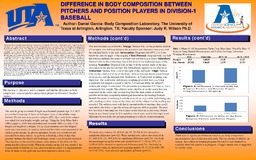
ATTENTION: The works hosted here are being migrated to a new repository that will consolidate resources, improve discoverability, and better show UTA's research impact on the global community. We will update authors as the migration progresses. Please see MavMatrix for more information.
Show simple item record
| dc.contributor.author | Garcia, Daniel | en_US |
| dc.date.accessioned | 2013-06-12T20:21:31Z | en_US |
| dc.date.available | 2013-06-12T20:21:31Z | en_US |
| dc.date.issued | 2013-06-12 | en_US |
| dc.identifier.uri | http://hdl.handle.net/10106/11751 | en_US |
| dc.description.abstract | Body composition measurements are becoming more relevant in the field of sports. Body fat percentage is a major value observed when these measurements of fitness are made. There are many different methods of recording this value, the most available and accurate being the underwater weighing method. Other values for body composition include the body mass index and waist to hip ratio of an individual. Baseball players need to be in peak conditioning during the season. Coaches are beginning to use these numbers as a prerequisite for the opportunity to play. Research has shown that the measurements that fall within certain categories are indicative of optimum athletic performance. The purpose of this study was to compare body composition between pitchers and position players in Division-1 baseball players. | en_US |
| dc.description.sponsorship | Wilson, Judy, Ph.D. | en_US |
| dc.language.iso | en_US | en_US |
| dc.subject | Body mass index | en_US |
| dc.subject | Baseball players | en_US |
| dc.subject | Skinfold measurements | en_US |
| dc.title | Difference in body composition between pitchers and position players in Division-1 baseball | en_US |
| dc.type | Presentation | en_US |
| dc.publisher.department | Body Composition Laboratory, the University of Texas at Arlington. | en_US |
| dc.publisher.department | Exercise Science Research Laboratories, the University of Texas at Arlington. | en_US |
| dc.publisher.department | Department of Kinesiology, the University of Texas at Arlington. | en_US |
Files in this item
- Name:
- Garcia research.pdf
- Size:
- 475.2Kb
- Format:
- PDF
- Description:
- PDF
This item appears in the following Collection(s)
Show simple item record


